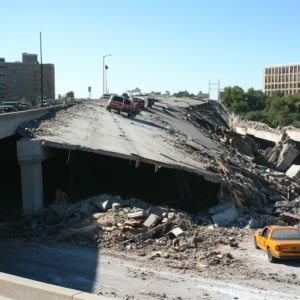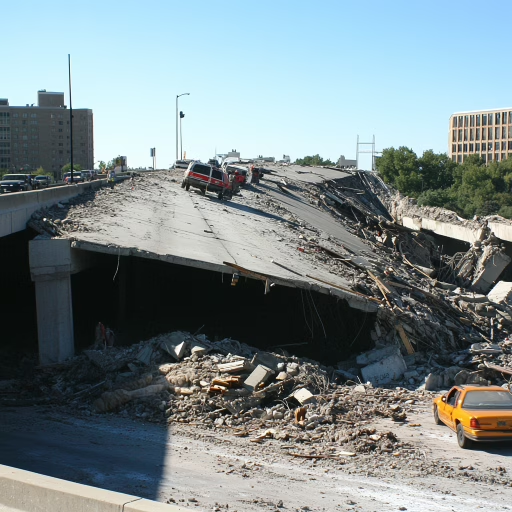Subtotal $0.00

On August 1, 2007, the I-35W bridge in Minneapolis collapsed without warning, plunging cars, construction workers, and commuters into the Mississippi River during the peak of rush hour traffic. Thirteen lives were tragically lost, and 145 people were injured. The catastrophic failure of this eight-lane steel truss bridge shook the nation, drawing urgent attention to the vital importance of infrastructure safety, engineering integrity, and proactive risk assessments.
While the collapse itself was sudden, the warning signs were deeply embedded in overlooked design flaws, outdated inspections, and a lack of modern risk management practices. This disaster remains a defining moment for infrastructure oversight, revealing how lapses in engineering assessments and risk planning can lead to irreversible consequences.
Engineering Oversight: A Breakdown in Risk Understanding
The I-35W bridge was constructed in 1967 and served as a critical transportation artery in Minneapolis. Over the years, it withstood heavy traffic volumes, wear and tear, and multiple construction activities. However, investigations following the collapse revealed a chilling truth — the bridge was operating under a dangerous combination of stress and flawed design.
The National Transportation Safety Board (NTSB) determined that the collapse was caused by a design error in the gusset plates, which were too thin to support the bridge’s weight, especially with added construction loads. There had been no risk assessments accounting for this during the years of inspections and maintenance upgrades.
This oversight wasn’t merely a structural issue—it was a failure of risk assessment systems. Had proper engineering risk assessments and a risk management solution been in place, the potential failure of these components could have been flagged and addressed years earlier.
Importance of Proactive Infrastructure Risk Assessments
What the I-35W tragedy laid bare was not just the vulnerability of physical infrastructure, but also the gaps in decision-making frameworks. Risk assessments must go beyond basic checklists and reactive inspection reports. In large-scale projects like bridge construction or urban development, risks need to be quantified, monitored, and revisited regularly.
Modern risk assessment modules help identify stress points, material fatigue, and risk accumulations using data analytics and modeling tools. These modules are built to evolve with the lifecycle of a structure, ensuring that new risks are assessed with every change in use, weight distribution, or nearby activity.
Professional Accountability and Safety Compliance
Another critical takeaway from the bridge collapse is the role of professional accountability. Engineers and contractors must adhere to strict industry standards—not only during the design phase but throughout the structure’s operational lifespan. Regular audits, compliance checks, and transparent documentation are key to long-term safety.
The absence of a unified enterprise risk management software system contributed to fragmented oversight in the I-35W case. When multiple entities are involved—from city planners to contractors—having a centralized platform for risk tracking, communication, and documentation ensures that crucial data doesn’t fall through the cracks.
How Risk Management Software Can Help Prevent Future Failures
Today’s infrastructure projects are larger, more complex, and more interconnected than ever. With urban expansion, climate changes, and increasing load demands, the margin for error continues to shrink. Fortunately, advances in risk management software now offer tools that were unavailable during the time of the I-35W bridge’s decline.
Such software platforms allow for:
- Predictive modeling of structural integrity based on design inputs and usage data.
- Integration of real-time monitoring data (e.g., sensors on bridges) with the risk assessment module to update safety statuses dynamically.
- Automated alerts for maintenance teams when risk thresholds are breached.
- Historical tracking of previous inspections and interventions, allowing decision-makers to visualize long-term risk evolution.
Through automation and integration, these solutions bring consistency, speed, and depth to the process of managing safety risks in critical infrastructure.
Building Resilience Through Smarter Risk Management
The collapse of the I-35W bridge became a wake-up call for governments and engineering firms alike. Since then, many states have overhauled their bridge inspection programs, increased funding for infrastructure, and explored smarter risk management practices.
One of the most impactful changes has been the adoption of structured risk assessments within project lifecycles. From planning to execution to maintenance, risk evaluations are now considered a continuous and collaborative responsibility rather than a one-time checkbox.
Moreover, organizations are embracing risk management solutions that encompass not just technical risks but also operational, financial, and environmental ones. A bridge today is evaluated not only for its ability to withstand weight but also for how it performs under emergency conditions, how nearby developments affect it, and how it will evolve in the face of climate stressors.
Conclusion: Preventing the Next I-35W Through Smart Technology
The I-35W bridge collapse was a tragedy that revealed glaring vulnerabilities in how infrastructure projects were managed and monitored. It taught us that when risk management is overlooked or underdeveloped, the consequences can be catastrophic.
Thankfully, technology has come a long way since 2007. The introduction of modern risk management software is transforming how we handle engineering, safety, and compliance. Whether you’re overseeing a construction project, managing public infrastructure, or ensuring workplace safety, adopting advanced tools like an enterprise risk management software or a customizable risk assessment module can significantly reduce exposure to danger.
At EHA Soft Solutions, we offer a robust suite of tools tailored to proactive risk control, compliance assurance, and real-time safety management. Our solutions empower organizations to conduct accurate risk assessments, create mitigation plans, and maintain a culture of safety at every operational level.
Explore our innovative risk management solutions today and take the first step toward building a safer, smarter, and more resilient future.
For more information on how our solutions can help your organization stay ahead, contact us today at +353 21 4536034 or email info@ehasoft.com. Visit our website www.ehasoft.com to learn more.







Comments are closed